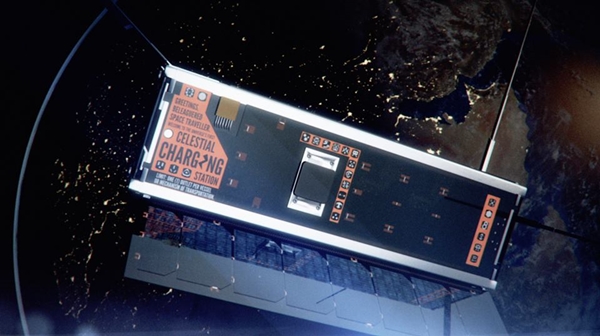Art & Exhibitions
Conceptual Artwork Invites Aliens to Recharge Their Phones
LA gallery launches participatory art piece into orbit.

Photo: Courtesy iam8bit, Los Angeles.
LA gallery launches participatory art piece into orbit.

Sarah Cascone

A Scottish company has just launched a new satellite into orbit, but unlike most that have gone before it, the UKube-1 satellite is decorated with artwork, reports the San Gabriel Valley Tribune. The design, from Los Angeles’s gallery and production company iam8bit, features an invitation to passing space aliens who need to charge their electronics.
UKube-1 is the product of Glasgow’s ClydeSpace and the UK Space Agency, and is the first satellite completely built in Scotland. The 10-pound device, which is small enough to be handheld, was launched at Kazakhstan’s Baikonur Cosmodrome early on the morning of July 7.
Despite UKube-1’s diminutive size, there was some blank space on the spacecraft’s exterior. “We’ve got some of iam8bit’s artwork in our office, and it’s quite techie and blocky and chunky, so it fit with what we were doing with the satellite,” Craig Clark, ClydeSpace’s founder and CEO, told the Tribune. “I asked them if they would like to put some miniature artwork on the satellite.”
Jon Gibson and Amanda White, the co-owners and creative directors of iam8bit, were initially skeptical of the unusual request. Once they determined that Clark meant business, however, they were more than happy to take part in the project.
“We are very into defining a context and building a mythos out of that context, so the context of satellite art would be how would someone interact with it,” Gibson said. Because humans won’t be looking at the work, “we wanted to provide some whimsy and cleverness for when these so-called aliens either come to greet us or destroy us.”
The artwork is also a commentary on how dependent modern society has become on its mobile devices. “Everyone’s attached to their phones, tablets, and desktops and we wanted to communicate that in a fun, whimsical way up in space. It’s partly reflective of what’s happening on Earth, but also outwardly presenting an ocean of humans being in on the joke,” Gibson explained.
A CubeSat satellite, first developed in 1999 to conduct space exploration and scientific research, UKube-1 is expected to remain in orbit for the next 25 years. It will conduct a variety of tests, take photographs, generate random numbers based on radiation particles in space, and monitor weather in far off space using GPS cycles.
Clark, who plans to open a Los Angeles office for ClydeSpace within the next year, hopes that other spacecraft will join UKube-1 in sporting “satellite tattoos,” bringing more art to space. Gibson, for his part, dreams of the day that iam8bit could become the first gallery in space.
The LA artist-gallerist duo is not the first to put art in orbit. Paul van Hoeydonck‘s Fallen Astronaut has been on the moon since 1971. Other notable pieces of space art include the Damien Hirst spot painting that was on board the failed 2002 Beagle 2 mission to Mars, the 2012 weather balloon-launch of Invader’s Space Invader mosaic, and Voyager 1’s Golden Record, which recently became the first piece of art to leave the solar system. There is also the Swedish artist who wants to build a house on the moon (see artnet News article).
UKube-1 isn’t even the first satellite to carry artwork in space, as the EchoStar XVI communications satellite sent Trevor Paglen‘s conceptual photography project The Last Pictures into orbit in 2012.
As for this latest bit of satellite art, Clark believes “it would be a great thing” for aliens to interact with UKube-1. “If they do stop by and see our satellite, it will be a nice, friendly welcome for them,” although he admits they probably won’t need to rely on its human technology to recharge their devices.